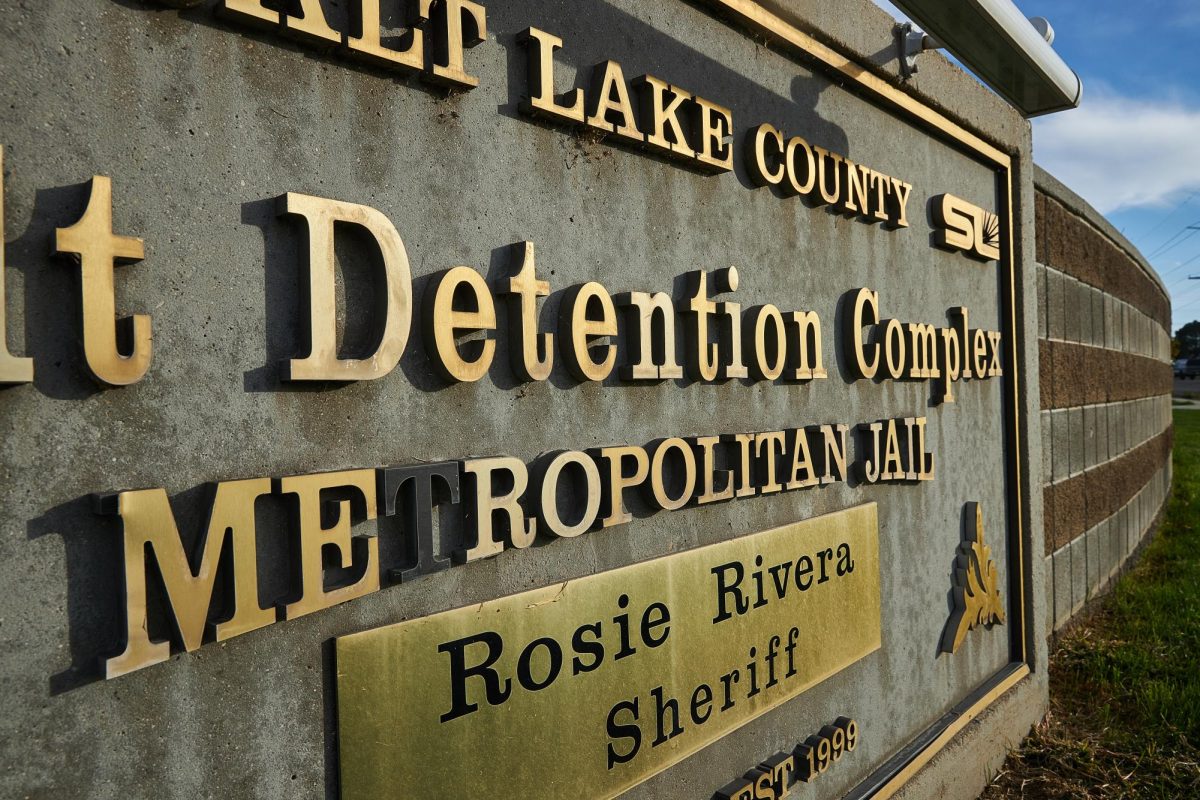Smog and the City: The Worsening Air Pollution in SLC
(Graphic by Sydney Stam | The Daily Utah Chronicle)
November 2, 2021
On Aug. 6, Salt Lake City recorded the worst air quality in the world according to IQAir, a Swiss-based air quality technology company. The very next week, Salt Lake topped the list again, ranking among other cities with notoriously poor air quality including Santiago, Dhaka and Lahore. Any Air Quality Index value above 100 is considered unhealthy. In both of these instances, the AQI value reached heights of 170.
Forest Fires Fuel Poor Air Quality
The driving force behind these numbers is forest fires. California and Oregon, Utah’s neighbors to the West, have experienced an unprecedented wild fire season thus far. A combination of scorching heat waves burnt the landscape to a crisp, opening the door for sparks to fly and leaving thousands of fire fighters to contain the flames.
Andrea Brunelle, a professor of geography at the University of Utah, researches paleoecology, fire history and climate change.
“You know we had a great example here a few weeks ago: the Parley’s Canyon fire, like the catalytic converter that vehicle sparked and set the grasses next to the road on fire,” Brunelle said. “Maintaining wider margins when we are in such a severe drought, away from roadways so that a dragging chain or a faulty catalytic converter or whatever doesn’t ignite, so trying to reduce ignitions is also someplace we can help.”
As of Sept. 28, 2021, the National Interagency Fire Center reported that “wildland fire fighters continue to work toward containment goals on 64 large fires and complexes that have burned more than 3.1 million acres” nationwide. A total of ten wild fires in California ruined 1,991,022 acres of land and a total of six wild fires in Oregon devastated 292,253 acres during this period. The smoke from these catastrophic events blows into Salt Lake City and wild fires in Canada and Montana only add to the smog.
Colleen Reid, an assistant professor of geography at the University of Colorado Boulder, first began research on the health implications of wild fire smoke in 2008.
“Back then, there was a sense that it was ‘natural’ air pollution, and if it was bad, it was only short-term, so it was not as much of a concern as pollution from factories and refineries and vehicles,” Reid said. “What we are realizing now, as these episodes of exposure last longer, is that wild-fire smoke can have measurable and potentially lasting health impacts.”
The United States Environmental Protection Agency reports that the fine particles produced by wild fire smoke penetrate deep into a person’s lungs. This can amplify the effects of chronic heart and lung diseases and cause runny noses, coughing, increased phlegm production and difficulty breathing. Studies have shown these particles may also correlate with premature death. Older adults, people with diabetes and younger children, among others, are particularly susceptible to adverse health reactions.
Great Salt Lake Dries, Utahns Pay
In addition to the negative impacts of smoke on air pollution, the drought has also decreased air quality. With less moisture in the soil, wind whips up dust particles easier, which then find their way into people’s lungs.
According to the NASA Earth Observatory, the Great Salt Lake is currently at its lowest point ever, because of human diversion of tributaries, as well as the chronic drought.
Researchers from Brigham Young University and the U concluded the dust along the Wasatch Front is 90% from the drying lake bed. They predict that as temperatures warm and the lake continues to evaporate, the percentage of deposition will only continue to increase.
When the dust is carried away, organisms and metals can also be transported, negatively impacting air quality and water resources. According to AP News, with more dry lakebed comes arsenic-laced dust in the air Utahns breathe. In 2021, the lake’s levels will hit a 170-year low.
Present research continues to investigate the long-term impacts of wild-fire smoke, but some short-term impacts on the human body and mind have already been studied. A 2020 study conducted by U researchers focused on the impact of air pollution on test scores in elementary-age children. Utilizing data from the 2016-2017 school year within all primary public schools in Salt Lake County, they looked at math and English language arts test scores. They found frequent peak exposures were associated with reduced math and ELA proficiency.
“Findings highlight the need for policies to reduce the number of days with peak air pollution,” the study said.
A team of 23 researchers from Utah analyzed scientific records and studies to discover the impact of air pollution and came to two notable conclusions. First, 2,500 and 8,000 premature deaths each year can be attributed to Utah’s air pollution, which lowers the median Utah life expectancy by 1.1 to 3.6 years. Secondly, they estimated that air pollution costs Utahns $1.9 billion annually.
IQAir reports that BYU researchers found an estimated 75% of Utahns lose one year or more of their lives due to state air pollution levels, with 23% losing five or more years. A study by the Massachusetts Institute of Technology found there are about 450 deaths yearly in Utah due to poor air pollution.
While the majority of Utahns have a home in which they can escape the smoke, the 3,565 homeless individuals across Utah do not often have a reprieve from these environmental conditions. With no place to go, their exposure to the toxins is significantly higher than those with homes.
Legislation for Cleaner Air
With an issue like air quality affecting every constituent, Utah legislators have a specialized Clean Air Caucus — a bipartisan collection of representatives focusing on strategies to minimize air pollution. From budget requests to evaluating the needs of the valley, efforts have been unified to make the Salt Lake Valley a better place for all to live.
According to Gov. Spencer J. Cox’s budget book, the legislature spent $28.7 million in air quality improvement initiatives in 2020. One recent bill, HB 123, includes the Feasibility Study for Air Quality Laboratory, which mandates the Division of Air Quality to explore the idea of opening a lab that would cover air pollution and climate solutions. Another is HB 91, the Tax Credit for Alternative Fuel Heavy-Duty Vehicles, which expands the income tax credit regarding certain alternative fuel heavy-duty vehicles.
Within Salt Lake County, organizations such as the Utah Clean Air Partnership aim to inform and educate the public on how to protect themselves and their loved ones.
Healthy Environment Alliance of Utah’s campaign for clean air is an acronym spelling out CLEAN AIR. It includes action items such as carpooling whenever possible, navigating smog ratings and engine types and riding a bike or walking. HEAL Utah also calls for companies to take accountability for their emissions, instead of simply blaming the consumer.
Noah Miterko, a senior policy associate with HEAL Utah who leads energy and climate work with the organization, said there are various actions that can be taken by individuals but he is hesitant to promote them because he believes they have been leveraged by state leadership to place blame on individual community members.
“The reality is, there are huge development decisions, there are huge industrial polluters on the Wasatch Front and we need the government to hold these polluters accountable,” Miterko said. “We need to make sure that we’re passing laws and regulations to continue with increased efficiency and reduce pollution.”
According to the Deseret News, Logan Mitchell, an atmospheric scientist at the U, said that Utah’s air quality could be improved with the heightened use of electric vehicles and the electrification of businesses and homes to eliminate natural gas.
In the future, Salt Lake City aims to utilize more renewable energy sources, expand public transit infrastructure and engage in local partnerships which amplify voices advocating for clean air. For instance, alongside Rocky Mountain Power, which provides the city’s electric utilities, Salt Lake City has committed to achieving net-100% renewable electricity by 2030 under HB 411, the 2019 Community Renewable Energy Act.
The Salt Lake City Department of Sustainability’s Climate Positive 2040 is a plan to transform Salt Lake to achieve its climate and energy goals. This holistic approach includes the promotion of cleaner transportation like buses and bikes, highly efficient new and existing buildings and sustainable food initiatives like reducing consumable food waste.
One part of the plan discussed city operations, saying Salt Lake City “leads by example” in its prioritization of “carbon pollution reduction and enhanced resiliency to climate change.” This part highlights the city’s efforts to have net-zero construction, meaning projects which include onsite or offsite renewable energy projects to offset carbon emissions of the building.
Within Climate Positive 2040, Salt Lake City is described as a resilient city, addressing climate change at the local level to mitigate its negative social, environmental and economic effects.
The plan ends by informing the individual reader how they can play a part in making Salt Lake City a cleaner community. Citizens are encouraged to commit to solar energy, reduce their carbon footprint by adjusting thermostats, eat less meat and more.
By 2040, the mayor and city council hope to reduce energy-related community carbon emissions by 80%, bettering air quality and improving Utahns’ lives.









